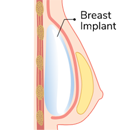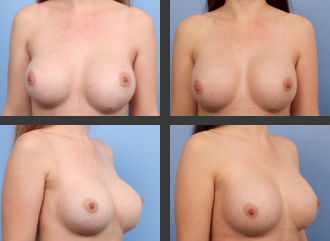What is Breast Augmentation?
Breast augmentation (augmentation mammoplasty) involves placing an implant behind the breast. This will increase breast size and upper pole fullness and lift the breast to a certain degree.
Women undergo breast augmentation for several reasons, such as volume loss after breastfeeding or weight loss, which may have significantly altered breast shape and size. In some cases, women who have had a mastectomy may want a breast augmentation as the first step of breast reconstruction.
Breast Augmentation with Dr Broadhurst
“I pride myself on the individual care and support I provide each of my patients. From your first consultation, I will work one-on-one with you to tailor a treatment plan to suit your body.”

Types of Breast Implants
The type and size of the implants you choose will depend on what size you want your breasts to be, your skin thickness and elasticity, breast anatomy, and body type. Dr Broadhurst will work with you to determine which choice is suitable for you, as there are many factors to consider.
The types of breast implants used for breast augmentation surgery include:
Silicone Implants
Silicone implants are made of a cohesive, elastic gel designed to mimic the look and feel of natural breast tissue. Even if your implants rupture or leak, the gel will stay together, reducing potential risks such as silicone migration and extracapsular spread.
Saline Implants
Saline implants contain a certain amount of sterilised saltwater surrounded by an outer silicone layer. They have a different feel, shape, and firmness than silicone implants. If a saline implant leaks, it will collapse, and the body will naturally absorb the saline.
You will need to decide on the shape of the breast implants. Both implant types are available in the following forms:
Round Breast Implant

Round breast implants are the most common breast implant shape. There are four different types of projection with round implants, which can influence the volume, upper pole fullness, cleavage, and overall shape. Round implants create more fullness at the top of the breasts and are suitable if you want to correct descending breasts for a fuller appearance.
Teardrop Breast Implant

Teardrop breast implants can make the bottom of the breasts fuller rather than the top. Breast volume and fullness are not lost; instead, it is concentrated around the bottom portion of the breast.
This process may seem overwhelming, but Dr Broadhurst will guide you in selecting options based on your body anatomy. There is no wrong choice; it depends on your individual needs and preferences, as each option has its pros and cons. The goal is to determine which choices suit you.
Consultation
What to expect during your consultation?
Dr Broadhurst will thoroughly discuss the shape, size, and style of your breasts and work closely with you to help you choose the most appropriate breast implants.
Dr Broadhurst will ask you questions about your medical history. He will then discuss your treatment plan in detail, as well as the appropriate implant type and size, incision placement, and implant shape. He will also explain what the procedure entails and what you can expect after surgery and during recovery.
Your Second Consultation
You will meet with Dr Broadhurst for a second face-to-face consultation at our Brisbane, Sunshine Coast, Hervey Bay, or Bundaberg locations. This consultation can be scheduled at the location nearest to you. The purpose of this appointment is to ensure that you fully understand the procedure and to address any concerns you may have. If you are deemed a suitable candidate for surgery, you can schedule the surgery date seven days after your second consultation.
Procedure
What to expect during your procedure?
Breast augmentation is performed under a general anaesthetic. The surgery roughly takes one hour to complete unless you combine breast augmentation with other procedures, such as an abdominoplasty.
Dr Broadhurst carefully measures and marks the implant ‘pocket’. An incision is made through the skin and down to the site where the implant is placed. He will create a dual plane pocket under and over your breast muscle to fit the implant. An internal bra is also used to support your implant and ensure it stays exactly where it is placed. Accurate implant pocket creation, precise implant placement, and attention to detail are critical to a successful surgery. Once the implant is inserted, the incision will be closed with internal dissolving sutures.
Breast Implant Placement
Sub-glandular Placement

Sub-glandular or ‘over the muscle’ is when the breast implant is placed above the pectoralis muscles but underneath the breast tissue. This method is suitable for patients with sufficient natural breast tissue to cover the implant. However, it can lead to visible implant edges, especially in those with thinner breast tissue.
Sub-muscular Placement

Submuscular or ‘under the muscle’ is when the breast implant is placed under the pectoralis muscle. This allows for more breast tissue coverage, helping to camouflage the implant. It also reduces the rate of capsular contracture (a firm scar that can form around the implant).
Dual Plane Placement

Dual plane placement is a combination of over and under the muscle. In this method, the upper part of the implant is positioned under the chest muscle (pectoralis major), while the lower part is placed directly behind the breast tissue. This approach is suitable for patients with mild to moderate degrees of breast descent.
Incisions & Scarring
An incision in the skin is required to insert an implant. The three most common types of incisions are infra-mammary (in the fold underneath your breasts), peri-areolar (semi-circle around the lower part of your nipple), and axillary (in the armpit). Dr Broadhurst performs a 4-6cm incision at the infra-mammary fold to reduce the visibility of scars. Depending on your physical activity, you should fully recover within one to two weeks.:


